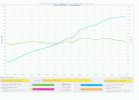Haha, I do have a good idea of what the answers are to the questions that I am asking, yes. I don't
know anything for certain, only making educating guesses, and putting the ideas out for discussion. The questions I am asking are not aimed at you directly, just to anyone reading in general. Hopefully people reading will answer the questions themselves and come to their own conclusions which we can then talk bollocks about for hours on end. That was the idea at least...

Exactly, so you lower the compression ratio to keep the cylinder pressures within the limits of the fuel!
Totally agree, not only is 100% difficult to achieve, it's also pretty hard to quantify exactly what VE you are acheiving at any given point. It can be done, but it's certainly not straightforward! I guess what we should think about is an increase over the peak VE as stock. So 105% VE should be thought of as a 5% increase over stock, whatever that might actually be nominally.
Back to the relation to forced induction. You increase VE with boost, which increases the cylinder pressures (compression ratio stays the same

) so you reduce the SCR to return the pressures back to within the limits of the fuel you are using, but with a greater effective displacement, which gives more power.
The same principals apply with NA and cams. You're trying to increase the effective capacity, (albeit marginally compared to FI), which works to increase cylinder pressures the same as boost would. You're never going to need to reduce compression to account for this, such is the marginal increase in VE that you are likely to achieve, but why is it percieved to require raised compression for big cams to work?

).gif)
 )
)





